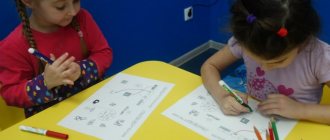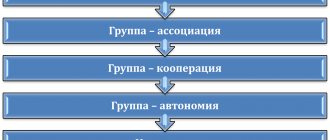School maladjustment is a child’s mental state, manifested by problems with discipline, learning, behavior, relationships with peers and adults. There are many options for the manifestation of maladjustment, as well as reasons. But the basis of maladaptation is the child’s inability to accept a new role and a new developmental situation.
Maladaptation most often occurs in primary school students, but also occurs when moving from junior to middle school and from middle to high school, or when changing place of education. In adolescence, this is often a consequence of previously unnoticed problems with adaptation. The task of parents and teachers is to identify maladaptation in time and help the child.
§ 1. The concept of social maladjustment………………………………………………………4
§ 2. Types of social disadaptation. Causes and consequences……………………………………………………………………………………….5
§ 3. Characteristics of younger schoolchildren……………………………………………………….7
§ 4. Technology of working with primary schoolchildren to prevent social maladjustment…………………………………………………………………………………..9
Conclusion………………………………………………………………………………………10
Introduction
Recently, an increasingly pressing problem that unites the efforts of psychologists and teachers is the problem of social maladjustment as a phenomenon that impedes the full personal development of a student and complicates the educational process. Psychological services at schools need research on disadvantaged children to develop adequate methods of psychological and pedagogical correction of their maladjustment.
Moreover, social maladaptation is both a consequence and a cause of the destruction of the child-adult community, which leads to general academic failure, deviant behavior, deterioration of the psychophysiological state of children, etc. And school problems often lead to problems in the student’s family. That is why it is important to work to identify and eliminate the causes of social maladaptation already in elementary school.
4 pages, 1987 words
Social project “Take care of yourself”
...limited at best. Young people, as a rule, cannot obtain the necessary education and take the place in society that they expected. Thus... it is necessary to carry out enormous preventive, informational and educational work among teenagers. Description of the project 1. Name of the project: Social project “Take care of yourself” 2. Description of the project (mission, uniqueness, goals and objectives, ...
The purpose of our research was the search and practical implementation of methods of psychological prevention and correction of social maladjustment in younger schoolchildren.
Types of manifestation of school maladjustment
1. Cognitive – manifests itself as the student’s general poor performance. There may be chronic underachievement, lack of skills, fragmentary acquisition of knowledge. Lack of adaptation to the collective pace - being late for lessons, taking a long time to complete a task, getting tired easily.
2. Emotionally - evaluative - there are violations of the emotional attitude towards individual lessons, teachers, and possibly to learning in general. “Fear of school” is a child’s reluctance to go to class, anxiety, tension. Uncontrolled manifestation of violent emotions.
3. Behavioral – weak self-regulation, inability to control one’s own behavior, aggression and conflict appear. Lack of learning motivation manifests itself in a reluctance to do homework and a desire to engage in other activities.
§ 1. The concept of social maladjustment
- Pedagogical dictionary:
Social maladjustment (Social maladjustment) is a violation of a person’s normal relationship with society, with people and, as a result, difficulties in communicating and interacting with them.
- National Encyclopedia of Psychology:
Disadaptation is any violation of adaptation, the body’s adaptation to constantly changing conditions of the external or internal environment. A state of dynamic discrepancy between a living organism and the external environment, leading to disruption of physiological functioning, changes in behavior, and the development of pathological processes. A complete discrepancy between the organism and the external conditions of its existence is incompatible with life.
3. Disadaptation is a violation of the processes of human interaction with the environment, associated with weaning from some familiar living conditions and getting used to others.
§ 2. Types of social maladjustment. Causes and consequences
Types of social maladjustment:
- Intellectual – impaired thinking;
- Behavioral – non-compliance of behavior with norms;
- Communication – difficulties in communication;
- Somatic – deviations in health;
- Emotional – anxiety and worries about school problems.
Signs of maladjustment:
- tired, tired look of the child;
- reluctance to share impressions;
- reluctance to do homework;
- complaints about events at school;
- restless sleep;
- difficulty waking up in the morning, lethargy;
- constant complaints of poor health, etc.
The reasons for school maladjustment include:
- social stratification characteristic of modern Russia (often within the same class, children from such different families find it difficult to find a common language, poorly understand each other and do not know how to communicate);
— an increase in the number of children with mental retardation (MDD);
— an increase in the number of children with neurotic and serious somatic disorders.
Psychologists note that difficulties communicating with others (both adults and peers) are a very significant component of schoolchildren’s maladjustment.
Factors of maladjustment:
- low social status of the child; family relationship problems;
- low willingness to help a friend;
- poor relationships with peers;
- low cognitive abilities;
8 pages, 3963 words
Psychology of children with behavioral disorders
...can be combined with the latter. 7. A feature of behavioral disorder is that it is accompanied by various manifestations of social maladjustment. The state of maladaptation, in turn, can be independent ... physical development and puberty. 1. Concepts used to characterize children with behavioral disorders The obvious complexity of this concept is due primarily to its...
- inadequate self-esteem
From the first days of school, the child faces a number of tasks that require the mobilization of his intellectual and physical strength. Many aspects of the educational process present difficulties for children. It is difficult for them to sit through a lesson in the same position, it is difficult not to be distracted and follow the teacher’s thoughts, it is difficult to do all the time not what they want, but what is required of them, it is difficult to restrain and not express out loud their thoughts and emotions that appear in abundance. In addition, children do not immediately learn new rules of behavior with adults, do not immediately recognize the teacher’s position and establish a distance in relations with him and other adults at school.
To optimize the adaptation period of children, they need to be helped to get acquainted with each other, with teachers, with a new learning situation, with school and school rules.
Afterword
If the child is happy with school and his whole life, then there will be no problems. This means that all work should be aimed at developing a positive attitude of the child towards life, himself, the environment, school and all participants in the educational process. Any activity that is significant to the child’s personality and gives him positive emotions, including communication as a separate activity, will help with this.
Read more about successful school adaptation, its signs and the role of parents in this, in the article “Psychological features of a child’s adaptation to school. Types and levels of adaptation." About the signs and factors of maladaptation - in the article “School maladjustment: what is it, causes and signs.”
§ 3. Characteristics of younger schoolchildren
Characteristic of the period 7–10 years is the transition to a new social status: a preschooler becomes a schoolchild. The main characteristic of this period is the combination in the child of the features of preschool childhood with new qualities characteristic of a schoolchild. During this period, active maturation of all anatomical and physiological structures and the maturation of the nervous system continues. A characteristic feature of this period is the formation of educational activities, which require from the child both great mental stress and activity, but not physical endurance. The quality of educational activities will depend on the extent to which the necessary prerequisites were formed in the preschool period. The following prerequisites are indicated: • General physical development State of vision, hearing, motor skills (especially the formation of small movements of the hands and fingers).
The state of the nervous system (the degree of its excitability and balance, strength and mobility; disorders of nervous activity, as well as the general state of health, primarily affect performance, which can negatively affect not only academic performance, but also the student’s attitude towards school, study and communication with peers). • Mastering a sufficient amount of knowledge and ideas about the world around us. Ideas about space. Ideas about time. Possession of basic counting skills. • Mastery of clear, coherent, grammatically and phonetically correct speech, the ability to carry out simple sound-letter analysis • Development of voluntary attention. Indirect memorization. The ability to listen to speech and teacher explanations. The ability to look and see, to concentrate on work. Remember what you need to understand something new. Ability to explain and draw appropriate conclusions. • Cognitive activity, desire to learn, interest in knowledge, curiosity • Communicative activity Willingness to work together with other children, cooperation, mutual assistance. The ability to obey the demands of adults. On the basis of these prerequisites, at primary school age the formation of new qualities necessary for learning begins.
12 pages, 5643 words
Formation of motivation for educational activities with mental retardation
... educational activities with mental retardation Systematic, targeted correctional and developmental work in a special school contributes to the formation of educational motivation in adolescents with mental retardation. ... voluntary regulation of activity suffers, others have reduced performance, and still others have more pronounced deficiencies in attention, memory, and thinking. How diverse...
During this period, very important psychological new formations appear: voluntary activity; the ability to plan your activities, evaluate your actions in terms of compliance with your goals; mastering self-control skills. Also, in the process of learning activities, the child’s ability to identify properties and concepts when solving specific tasks, to master learning activities, control and evaluation is formed. Skills of volitional regulation of activity and behavior are formed. During the first years of school life, changes also occur in the emotional-volitional sphere. An adequate self-esteem and level of aspirations corresponding to the level of its development are gradually formed. His emotions become more stable and strong-willed qualities are developed. Mental new formations find vivid expression in the development of cognitive processes. Perception becomes more focused and voluntary. The volume of attention, the ability to concentrate, distribute, and switch are expanding. Particular attention should be paid to the new formation in the development of memory - the transition to indirect memorization, mastery of memorization and reproduction techniques. Internal self-regulation and control begin to occupy an important place in mental processes. Also an important psychological new development of school age is the transition to sign-symbolic activity. The use of graphic diagrams and symbols when solving educational problems requires a fairly developed imagination and a qualitatively new, higher level of thinking. In the first grade, visual forms of thinking continue to be the leading ones; by the second or third year of schooling, the child begins to carry out analysis and synthesis based on ideas and mental comparison. The development of the verbal-logical form of thinking occurs.
Diagnostics
Several methods can be used to diagnose school maladjustment. I propose to consider an observation map for diagnosing all ages and separately methods for primary schoolchildren and adolescents.
Observation map
D. Stott's observation card is a ready-made form with statements, in which it is proposed to enter answers about the correctness of these statements regarding a particular child. A total of 16 blocks are presented, that is, all symptoms are divided into symptom complexes. This allows us to establish the features of maladjustment:
- distrust of people, things, situations;
- depression;
- withdrawal;
- anxiety in relationships with adults;
- hostility in relationships with adults;
- anxiety regarding peers and other children;
- asociality;
- hostility towards children;
- restlessness and restlessness;
- emotional stress;
- signs of neuroses;
- unfavorable development conditions;
- problems in the field of sexual development;
- mental retardation;
- diseases and pathologies;
- physical disabilities.
The points determine the fact of maladjustment, the severity of each symptom complex and its role in maladjustment. The card can be used for both primary schoolchildren and teenagers.
This is an extensive and multifunctional (quality and quantity, congenital and acquired causes, severity of individual causes) method for studying maladjustment. But the disadvantage of the technique is that a more complete observation can only be carried out by a school specialist, but even then not always, subjective errors in the assessment are possible. In addition, this is a time-consuming method to implement.
Junior schoolchildren
To diagnose younger schoolchildren, especially first-graders, the questionnaire of L. M. Kovaleva and N. N. Tarasenko is often used. The technique is also focused on observation of the child by teachers, but as in the first case, any adult who knows the child well can answer the questions.
The questionnaire includes 46 questions, which are divided into blocks (possible causes and factors of maladjustment):
- parental attitude towards the child;
- readiness (unreadiness) for school;
- left-handedness;
- neuroses and neurotic symptoms;
- infantilism;
- hyperkinetic syndrome (impaired attention, hyperactivity and impulsivity), excessive disinhibition;
- inert nervous system;
- weak voluntary mental functions;
- lack of educational motivation;
- asthenic syndrome;
- intellectual disabilities.
The maladjustment coefficient is calculated. Among the possible options: normal adaptation, average degree of maladjustment, severe maladaptation, indications for visiting a neuropsychiatrist (congenital problems).
Teenagers
When diagnosing adolescents, you can use complexes of diagnostic techniques to analyze individual areas:
- personality accentuation tests;
- Phillips anxiety test;
- method “Home. Tree. Human";
- method of unfinished sentences;
- SAN questionnaire (well-being, activity, mood);
- Thomas test (behavior in conflicts);
- Q-sort (self-esteem analysis);
- SMIL (standardized multifactorial method of personality research);
- test of value orientations;
- T. Leary “Diagnostics of Interpersonal Relationships”;
- Furman A. “How adapted are you to life.”
Observations about the maladjustment of adolescents indicate:
- Developmental delay, with the exception of mental retardation.
- Problems in mastering school knowledge and academic performance.
- Underdevelopment of speech, problems in the form of insufficient vocabulary, difficulty in generalizing, systematizing and other functions of speech. Weakness of inner speech.
- Lack of cognitive activity, curiosity and verbal-semantic memory.
- Aggression towards people, things, animals.
- Feelings of inferiority.
- Excitability and conflict.
- Inadequate self-esteem.
- Running away from home and/or school.
- Deviant behavior.
Both among younger schoolchildren and among teenagers, the composition method can be used to determine their true motives, needs and interests (for younger children - a fairy tale, for older children - a story).
§ 4. Technology of working with younger schoolchildren to prevent social maladjustment
Various causes of school maladaptation cause the same manifestations: learning difficulties and behavioral disturbances. Psychological work can go in two directions - with cause and effect (i.e. with symptoms).
School psychologists focus their activities on eliminating symptoms.
Since learning difficulties are often associated with underdevelopment of the cognitive sphere, it is the cognitive processes that need to be developed: attention, memory, thinking. Most preventive and correctional programs for the development and/or formation of attention are based on a method developed within the framework of the concept of the gradual formation of mental actions (P.Ya. Galperin, S.L. Kabylnitskaya).
17 pages, 8485 words
A child’s psychological readiness for school depending on the level...
… memory development……… Conclusion…………………………………………………………..………..…… References………………………… …………………………………… Introduction Psychological readiness for schooling is understood as the necessary and sufficient level of mental development of a child to master school... schooling is the prevention of school maladaptation. ... to school and educational activities in ... to take a new social position ...
The process of developing logical memory is specially organized, since it is believed that children of primary school age resort to repetition in order to remember. Correctional programs dedicated to memory development can be found in specialized literature - in the works of L.M. Zhitnikov, E.L. Yakovleva, in a series of books on the development of memory by I.Yu. Matyugin and others.
The works of M.N. Akimova and V.T. Kozlova, S.M. Bondarenko, E.V. Zaika, N.F. Talyzina and others are devoted to the directed work on teaching children the basic techniques of mental activity. Special games and exercises for the development of motor skills in children children are widely represented in pedagogical and psychological literature - in the works of V.P. Matytsin, in the book “Psychohygiene
Correction of maladjustment in first-graders
- Model of correctional and developmental work for children
- with school maladaptation 6-7 years old Adaptation to school
Adaptation to school of a six-year-old child should be understood as:
a) physiological adaptation, as the process of adapting the functions of a child’s body to the learning conditions at school;
b) socio-psychological, as a process of active adaptation of the “child-adult”, “child-child” system to new conditions of interaction. Social and psychological adaptation includes the development of the child’s cognitive sphere and his ability to subordinate perception, memory, thinking, and imagination to the tasks that are set before him in the learning process.
Adaptation to new social relationships and connections in which the child’s personality begins to manifest itself is determined by how the child enters a new group of peers, what place he begins to occupy in the class, how he communicates with peers and adults, how he relates to school, to himself as schoolboy.
Of great importance when adapting a child to school is the level of education of the parents, the absence of conflict situations in the family, correct methods of education, full communication with the child, and interest in preparing the child for school.
- Causes of school maladjustment
They can be of a subjective and objective nature.
Subjective reasons for maladjustment:
- Insufficient level of motivation to study at school. A negative attitude towards school, the primary reasons for which may be the insufficiently professional work of preschool institutions, a pattern of negative attitudes towards school among brothers and sisters, etc.
Secondary destruction of motivation occurs directly in the learning process.
- Lack of formation of elements and skills of educational activities, the cause of which can be both individual characteristics of the development of intelligence and pedagogical neglect.
- Inability to voluntarily regulate behavior, attention, and educational activities. The reason may be an unfavorable family environment, improper parenting methods, improper organization of the child’s daily routine, as well as the consequences of complications during pregnancy and childbirth in the mother.
- Inability to adapt to the pace of school life. More often this happens in children who are somatically weakened, with delayed physical development, or disturbances in the functioning of analyzers.
- Objective reasons for school maladjustment
:
- Wrong attitude of teacher towards student.
- Incorrect organization of the educational process.
Depending on the severity of symptoms and their combination
The following forms of adaptation and maladaptation are distinguished:
- The norm is a favorable course of adaptation, accompanied by weak
the severity or absence of negative symptoms of maladjustment.
- “Hidden” forms of maladjustment (YES):
1st degree – the initial form of “hidden” DA. Characterized by an average level of performance, reduced emotional tone, partial disinhibition, and tearfulness. increased fatigue. The desire to go to school is unstable. He is diligent, but slowly integrates into the educational process, activity is replaced by passivity, and responds adequately to comments. There is anxiety and uncertainty in behavior.
2nd degree – a progressive form of “hidden” DA. Characterized by low performance, high fatigue, the child cannot concentrate, is whiny, touchy, and irritable. Sometimes he complains of headache, nausea, and abdominal pain. Negative attitude towards school, passive in class, silent when asked to respond, indifferent to failures.
Needs constant supervision and assistance from a teacher. Aggression towards children is occasionally observed as a protective reaction of the body.
- “Open” forms of maladjustment
3rd degree - the initial form of “open” YES. Characterized by a medium-low level of performance, impulsiveness, disinhibition, unstable attention, decreased appetite, restless sleep. He is not collected in class, quickly loses interest in tasks, and sometimes creates a conflict situation in educational activities.
4th degree - progressive form of “open” DA. Characterized by low performance, high fatigue, impulsiveness, disinhibition, irritability turns into aggressiveness.
Negative attitude towards school, teacher, quickly loses interest in assignments, refuses to complete them, is indifferent to failures, has a negative attitude towards comments, interferes in class, needs constant monitoring. There is a decline in the success of learning, and demonstrativeness is manifested in communication with the teacher. He makes faces, refuses to comply with the teacher’s demands, and creates a conflict situation. When communicating with children, he is aggressive, calls the children names, and complains to the teacher.
- Tasks of correctional and developmental work:
- Diagnosis of the causes of maladjustment
- Identification of development resources, family and school opportunities
3. Selection of a correctional and developmental program that takes into account both the causes of maladjustment and the identified resources in order to further develop the necessary structures of the child’s personality in artificially created conditions and transfer the developed skills to the social situation of the child’s development,
- Goals of psychological intervention:
- Change the child’s condition by creating a “supportive environment” and organize the formation of functions that contribute to further development.
- Change the attitude of adults towards the child, informing them about the child’s condition and capabilities and creating their expectations for his recovery from the crisis to further development.
A psychologist can influence not only directly (in individual and group work), but also through parents and teachers, changing through them the system of requirements and subordinating them to the current situation of the child’s development.
- Stages of correctional and developmental work:
- Creation of an artificial correctional and developmental environment with specially organized activities corresponding to the identified level of development of the child, i.e. an environment in which the child’s activities will be successful. At the same time, the requirements for the child (at school and at home) should be relaxed for some time.
- Transferring individual acquired skills to the current situation of his life and organizing ways to consolidate them.
- Expansion of the artificially created environment to the current situation of the child’s development, formation of goals for his further development and motivation for achievement.
- Schemes and procedures for correctional and developmental work
Individual work
It can be carried out in the following modes:
- Initial appointment,
at which a conversation is carried out with parents and the child, diagnosis of the child’s problems, choice of direction for correctional and developmental work, planning of a program and activities that include parents and other significant adults in the correction process.
- Corrective and developmental work
in an individual mode (appointments in the presence of parents are possible). Part of the program is carried out in the homework mode, which is completed by the child independently or with the help of interested adults.
- Advisory mode.
2-3 visits to a psychologist during work. The correctional program is mainly carried out under the guidance of parents. Parents can turn to a psychologist for help during the work process, and the specialist periodically receives feedback on the results of the work.
Group work
- Group work in the form of correctional and developmental training with a stable group of participants and a pre-designed program.
- Group care in a rotating group with a flexible program. In this case, you can include parents in the work and combine group work with individual work.
Homework is given to practice and reinforce skills.
- Stages and methods of correctional and developmental work:
- Determining the current level and zone of proximal development of the child, as well as the resources for its development and discussing with the child and parents the possibilities and ways of using them in the existing social situation.
- Help in forming a positive goal for the child, i.e. creating his model of a need-based future, as well as orienting the child to achieve his goal, taking into account his needs and personal characteristics.
- The choice of ways to achieve set goals, including the program and mode of classes in artificially created conditions, as well as ways to switch the developed skills to the social situation of the child’s development.
Any individual program involves the following basic steps:
- Block of work with emotional state, motivation and self-esteem.
- Block of development of brain structures, coordinated operation of perception systems, control of programming of purposeful motor acts.
- Block for the development of cognitive processes and skills in educational activities,
- Block for developing communication skills and social norms of behavior.
The specific content and mode of classes are selected taking into account the “center of gravity” of the child’s main problems identified during the examination.
In the case where the main problem lies in the area
his emotional state (anxiety, fears, depression), first of all, it is necessary to work with the method of psychotherapeutic influence.
If fears have a real basis in the form of a hostile attitude towards the child from others, then it is also necessary to work with society (for example, a parent or teacher) to change this attitude, as well as simultaneous work to change the type of reaction of the child. If the child's fears are associated with psychological distortions of early childhood, then the result is the child's distrust of the world as a general attitude that determines the way he reacts. It is also changed using psychotherapy methods (for example, symbol drama).
A depressive state, in general, is characterized by a lack of developmental resources, that is, the child’s unpreparedness for cognitive and personal growth. In this case, consultation with a pediatric psychoneurologist is necessary.
A state of anxiety accompanies any stressful situation. It can be reduced by introducing the child to a situation of success in a specially created environment. However, if anxiety is caused by hypersensitivity as a typological personality trait, it cannot be reduced below a certain level. In the latter case, increasing the child’s stress resistance should be associated with teaching him ways of behavior and effective interaction that correspond to his personal style.
If the main problem is related to the immaturity of brain structures and the coordinated work of analyzers, then these problems are solved using body-oriented training and educational kinesiology methods.
In case of unformed cognitive processes and skills in educational activities, cognitive training methods are used, as well as various developmental programs.
If problems are related to undeveloped social skills and communication difficulties, elements of communicative socio-psychological training are used.
All of these methods are used in different combinations when drawing up an individual correctional development program.
So, when overcoming school anxiety you need to:
1) reduce, soften the strength of needs associated with the internal position of the student;
2) develop and enrich operational skills of behavior, activity, and communication.
The main methods used in this case:
- sequential desensitization methods;
- method of “responding” to fear.
You can use dramatization games, for example, “To a very scary, scary school.” It’s good to read, supplement and act out excerpts from E. Uspensky’s book “School of Clowns”. In this case, the perception of rules as categorical requirements is removed while simultaneously realizing the meaning of the rules, which contributes to the development of arbitrariness.
As an example of group work, we will give a description of the methodology for developing the foundations of voluntariness of mental regulation and correction of attention deficiencies.
- METHODOLOGY FOR DEVELOPING THE FOUNDATIONS OF ARBITRANITY MENTAL REGULATION
The main methods used in this case are the techniques of psycho-gymnastics, emotionally communicative, behavioral training, and auto-training.
The structure of each lesson consists of two parts:
I. General warm-up. Developmental games are a must
attention (for example, “What has changed in this room”, “Guess who
touched, who approached, who shook hands more firmly”, etc.) and any
outdoor game.
2. Psycho-gymnastics - mastering the skills of controlling motor and
emotional sphere.
It is important to alternate movements that are opposite in nature, accompanied by alternating muscle tension and relaxation.
You can use games and exercises, examples of lesson planning options described in the following literature:
- Chistyakova M.I. Psychogymnastics, M., 1995.
- Ovcharova R.V. The child comes to school. M., 1996.
- Korotaeva E. I want, I can, I can! M., 1997.
- PSYCHOCORRECTIONAL ASSISTANCE PROGRAM FOR ATTENTION DEFECTS
Part
I - diagnostic and motivating;
Part
II - formative (10-15 lessons);
Part
III - supporting.
The first two parts are conducted by a psychologist, the third part by parents.
Each lesson consists of two blocks;
- Development of basic properties of attention.
- Development of arbitrariness through the development and strengthening of the volitional qualities of the individual.
Objectives of the diagnostic and motivating part:
- determine the level of development of attention;
— to form an initial level of motivation among schoolchildren to work with a psychologist.
The diagnostic and motivating part of the psychocorrection program is carried out on an individual basis.
Formative part (each lesson 60-90 minutes of group work)
Tasks:
correction of the basic properties of attention;
development of voluntary attention.
- Approximate plan of group psychocorrection classes for children 6-7 years old with insufficient development of voluntary attention, accompanied by increased motor activity and impulsivity
- Lesson 1
Target:
development of the ability to concentrate, stability of attention. relieving emotional stress, creating an attitude towards cooperation.
1. A conversation during which the psychologist explains to the children how the classes will be held and why they are needed. He asks what favorite activity each of them has in order to get to know each other better and establish emotional contact.
2. Outdoor game “Gawkers” (Chistyakova M.I., 1990) All players walk in a circle, holding hands. At the leader’s signal, the children stop, clap their hands 4 times, turn around and walk in the other direction. Anyone who fails to complete the task is eliminated from the game.
- Attention exercise “Find the difference” (Lyutova E.K., Monina G.B.) Children take turns drawing a picture on the board and turning away. The psychologist completes a few details. Children must say what changes have occurred.
- Game “Take and Pass!” Children sit on chairs arranged in a circle and pass each other some imaginary object. From the outside it should seem that they are working with real objects.
- Psychomuscular training “On the seashore”. Having played enough in the water, children go ashore and lie down on the sun-warmed sand of the beach. Close your eyes from the bright sun. They spread out their arms and legs in pleasant laziness.
Lesson 2
Target
: Formation of motivation to attend classes, desire to cooperate; development of stability of attention and self-control.
- Greeting, conversation on a free topic (establishing emotional contact)
- Warm-up: “Forbidden movement.” Children stand facing the leader. Repeat the hand movements shown by the presenter. Then a movement is selected that is prohibited from being repeated. The one who repeats the movement leaves the game.
- Games for attention:
“Search non-stop” For 10-15 seconds. see around you as many objects as possible of the same color (same size, same shape, etc.) At a signal, one child begins to list, the others complement it.
"Remember the order." Show the players 6-7 colored pencils in their hands. After 20 seconds, having removed them, ask about the sequence in their location.
5-6 people line up in a random order. Presenter for 30-40 sec. turns in their direction and, turning away, lists who is behind whom. Then someone else becomes the driver.
- Reading the fairy tale “The Little Imp, or the Boy, Vice Versa.” (Psycho-gymnastics. M.I. Chistyakova.)
An imp boy lived in a swamp. Sometimes people walked along the path past the swamp. The little devil really liked people, he wanted them to like him too, so when he sees someone, he immediately jumps onto a hummock and lets dance on it - only dirty water flies in all directions. For some reason, those passing by quickened their pace, pinched their noses, and turned their faces away from the imp. The little imp did not know that the smell of rotten water was unpleasant, that his antics and grimaces were frightening, and his wet, tattered clothes, strewn with leeches and snails, made everyone feel sick.
But one day a kind man was walking along this path. He did not turn away from the imp, did not hold his nose, but called him to him. The kind man pulled out a magic pin from his pocket and fastened it to the little devil’s clothes. And at that very moment the swamp disappeared, and in front of him stood a beautiful and clean boy.
The boy, a former imp, asked to live with a kind man.
So they began to live together. A good man says: “Open the door!” - and the boy closes it tighter; “Brush your hair,” and the boy ruffles his hair.
The kind man realized that the imp turned into a boy, but vice versa. He did not scold the boy, but began to say the opposite: “Beat this crybaby girl,” and the boy began to calm her down. That's how they lived.
Discussion of a fairy tale. Drawing characters.
- Muscle relaxation exercise “On the seashore”.
- Lesson 3
Target
: Develop volitional regulation skills and the ability to concentrate.
- Greetings, warm-up.
“I see...” (Karpova E.V., Lyutova E.K.; 1999)
Participants, sitting in a circle, take turns naming objects that are in the room, beginning each statement with the words: “I see...”.
You cannot repeat one subject twice.
- Attention exercise – working with proofreading tests;
- Drawing on the theme “On the way to school”;
- Discussion of children's drawings;
- Outdoor game “The King Said.” All participants in the game, together with the leader, stand in a circle. The presenter says that he will show different movements (physical education, dance, comic), and the players should repeat them only if he adds the words “The King said.” Whoever makes a mistake goes to the middle of the circle and performs some task for the game participants, for example, smile, jump on one leg, etc.
- Relaxation exercise.
- Lesson 4
Target
: Is the same.
- Claps in a circle.
- "Confusion". The leader goes out the door, and the children themselves get confused. The presenter must untangle them. Nonverbal communication exercise: Say hello while looking into each other's eyes. Say goodbye in the same way.
- Attention exercise: working with proofreading tests.
Exercise "Find the differences."
The children are given a pair of identical drawings with minor differences. We need to find out how they differ. For example, 2 clowns and 2 nesting dolls.
- Outdoor game “Freeze” (Chistyakova M.I., 1990) Children jump to the beat of the music (legs to the sides - together, accompanying the jumps with clapping overhead and on the hips). Suddenly the music stops. The players must freeze in the position at which the music stopped. If one of the participants fails to do this, he is eliminated from the game. The music sounds again - those remaining continue to perform the movements. They play until there is only one player left in the circle.
- Game "Path of Trust". Strengthens trust within the group, develops tactile perception. One child puts on a blindfold, the second leader. The leader leads a friend to different objects, and he determines by touch what they are. Then the bell rings and the guys change places.
- Relaxation exercise.
- Lesson 5
Target
: development of voluntary attention, imagination.
- The game “Touch” develops curiosity, attentiveness, and tactile sensations. Used as a warm-up.
Sit in one common circle, look around. And then the guys take turns touching something and telling them what it is. Then you can walk around the room, touching different objects and describing them. At the end of the game, you can draw something from what you touched.
- Claps in a circle.
- Writing a story together on the topic “How the naughty hare studied at school.” Everyone in a circle comes up with a continuation of the story.
- Outdoor game.
- Attention exercise: working with proofreading tests, game “What do you hear?” Children listen carefully to extraneous sounds and name them.
- Relaxation exercises.
- Lesson 6
Target
: development of attention, imagination, self-control, listening skills.
- Warm up. Throw the ball around in a circle, saying the name of the person you are throwing to.
"Mirror". The group is divided into pairs. One reflects, and the second performs an action (washes, eats, combs his hair). Do it slowly.
- Game "Stone of Wisdom". The game improves interaction and makes it possible to control your behavior. While the stone is in the hands of one child, the rest cannot speak. Then the stone is passed on to another, and so on. You can pass the stone to a child who just wants to share something.
- A game of attention. "Who's wearing what?" Everyone looks carefully at one participant, then he leaves the room, and the guys must remember what he is wearing, what color his clothes are.
- Outdoor game “Catching mosquitoes” (Lyutova E.K., Monina G.B.) Tell the children: “Let’s imagine that summer has come, I opened the window and a lot of mosquitoes flew into our class (group). At the command “Start!” you will catch mosquitoes. Like this! The teacher makes chaotic movements in the air at a slow or medium pace, clenching and unclenching his fists. Either one by one, or simultaneously. Each child will “catch mosquitoes” at his own pace and rhythm, without hurting those sitting next to him. On the command “Stop!” you sit down like this: the teacher shows you how to sit down (at your discretion). Ready? “Start!”… “Stop!” Well done. Tired. Lower your relaxed legs down and shake your palms several times. Let your hands rest. And now - again for caring!
- Imagination game "Blots". A sheet of paper is folded in half. An ink is placed on one side. Then the sheet is folded, unfolded and the guys come up with what object or something else they got.
- Relaxation exercise.
- Lesson 7
Target
: Development of voluntary attention, self-control, correction of motor activity.
- Warm up. Game "Photographer". The leader remembers the location of the group members and goes out the door. The guys make three changes to their composition. The presenter must restore the original composition.
Pantomime. “I love”, “I don’t love”. The guys show what they love. Others will recognize it by their movements.
- Game "Stone in the Shoe". The psychologist asks the guys how they feel, what they do if a pebble gets into their shoe. The guys answer. Then the psychologist says that everyone can have some kind of trouble, comparing it to a pebble in a shoe. If you talk about it and share it, it will become easier. It's like getting rid of a pebble in your shoe.
- Outdoor game "Stream". Children are divided into pairs. Couples join hands and raise their arms up. The couple stands behind the couple, forming a passage. One child remains. He walks under the hands, choosing someone for himself. The remaining one does the same.
- Attention exercise. The presenter names and repeats several movements once or twice, without showing them. Children must make movements in the same sequence in which they were named by the leader.
- Drawing on a free theme.
- Relaxation exercise.
- Lesson 8
Target
: Summing up group lessons.
- Conversation with children and parents about what the course taught them.
- Farewell, sweet table.
Based on the results of group lessons, it is advisable to offer individual lessons to children for whom the corrective effect is hardly noticeable.
- Recommended reading
1.S. A. Igumnov. Clinical psychotherapy for children and adolescents. Minsk: “Belarusian Science”, 2001
2R. V. Ovcharova. Practical psychology in elementary school. M.: Sphere shopping center, 1996
- Chistyakova M.I. Psychogymnastics. M.: Education, 1990.
- E. K. Lyutova, G. B. Monina. Cheat sheet for adults. M: Genesis, 2000.
9








